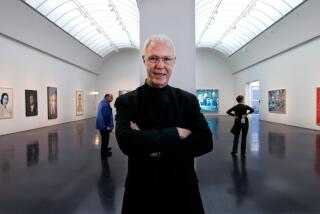L.A. Festival Was More Than an Arts Celebration : Culture: The city got to better know its multiethnic and intergenerational self. But institutionalizing the fest would kill its spirit and mission.
A great deal was written and said about the just-completed Los Angeles Festival. Some hailed the arts celebration as a huge success and a groundbreaking event. Others complained that the festivalâs brochure bewildered them, dampening their interest.
Without a doubt, the 1990 Los Angeles Festival was a triumph. Indeed, a page in the cultural and racial history of the city has been turned.
As planned, 290 events, 70% free, were presented at more than 70 venues across the city. Audience attendance at festival events requiring tickets was, on average, 73% of capacity, well above the projected 60%. The 16-day festival earned $725,000, $125,000 above projected.
As for the quality of the art presented, audiences and critics basically agreed--festival fare was exotic and excellent. Never before had Los Angeles seen such companies as the Bread and Puppet Theatre, the Children of Bali, El Gran Circo Teatro de Chile, Japanâs Uwanuda Kagura Troupe, the Wallis & Futuna Musicians and Dancers, and the Cambodian Classical Dance Troupe. They were the brilliant substance of an arts festival that truly reflected Los Angeles itself.
Add to this the multiethnic and intergenerational audiences, and you had something special happening. Latino families experiencing Thai folk opera in Alhambra Park; a predominantly white audience cheering the F.A.M.E. Gospel Choir at the Hollywood Bowl; young people discovering a 400-year-old folk dance with the townspeople of Gujo Hachiman, Japan, at Santa Monica Pier; parents taking their children to an airport hangar for their first taste of theater--courtesy of Bread and Puppet Theatre. The non-subscription sellout of âNixon in China,â directed by festival director Peter Sellars, suggested that many who attended the performance were introduced to the Music Center.
There were other artistic precedents: The F.A.M.E. Gospel Choir, long a staple of South-Central Los Angeles, sharing equal billing with the Los Angeles Philharmonic. Barbara Carrasco unfurling her mural, âThe History of Los Angeles,â at Union Station. Since 1981, it had languished in Cesar Chavezâs garage because the city, after commissioning the mural, apparently forgot it.
For me, one moment embodied the festivalâs purpose. In The Timesâ account of festival attendance in Santa Monica, it was reported that a man had stumbled onto an event at the pier. Although he knew nothing of the Los Angeles Festival, the unwitting participant in art fulfilled Sellarsâ strongest mission--to take the festival into so many communities that it could not be missed. The free, outdoor events--at Angels Gate in San Pedro, Descanso Gardens in La Canada-Flintridge, Griffith Park, Reseda Park, San Julian Park, the Wat Thai Temple in North Hollywood, Olvera Street, Chinatown and the African Marketplace--were thus the heart of the festival.
The festival also broke new fund-raising ground. We received support from contributors whom traditional sources warned us would never come forth. The local Korean, Cambodian, African-American, Chinese-American and Latino communities provided key financial assistance through fund-raising entertainment, neighborhood parties and other events. These new sources, along with the reliably strong support of Mayor Tom Bradley, our city partners, the Japanese business community, the Los Angeles County Transportation Commission and corporate and private funders created the foundation for the entire arts enterprise. They will be the keys to future fund-raising.
In planning for 1993, we must also admit that because of the breathless fund-raising pace at which we were operating, the organization of the 1990 festival began a full year too late. With monies in place earlier, we would have had more time to tend to the monumental task of producing and marketing the 1993 event. The 1990 Festival was an extraordinarily complex enterprise, and, quite simply, we must learn from our mistakes.
In the euphoria of the moment, some want to institutionalize the arts festival, to make it an officially sanctioned and funded part of the cityâs cultural life. As someone who has chaired the â84, â87 and â90 festivals, I approach such calls with caution. I would never wish to lose the lean-and-mean approach that constant lack of funding has forced on us. Nor would I ever want to lose our passion and the devotion of 1,100 volunteers, the daily miracles performed by 50 staffers, the indefatigable services of our volunteer board of directors and the unbridled courage of the Open Festival.
It is accessibility--both geographic and economic--to the arts in Los Angeles that should be institutionalized, not a cultural seniority system. The Los Angeles Festival is not about a building or paying homage to patrons. Rather, it is a model to be replicated throughout the country, a spirit to be carried forward.
I remember a conversation I had with Sellars in 1987. He told me the message of the 1990 Los Angeles Festival would be a simple one: to encourage this diverse community to get to know itself as it moves into the next century.
The message has been received.
More to Read
The biggest entertainment stories
Get our big stories about Hollywood, film, television, music, arts, culture and more right in your inbox as soon as they publish.
You may occasionally receive promotional content from the Los Angeles Times.










